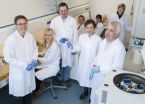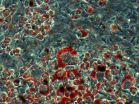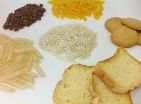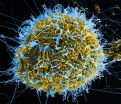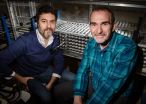(Press-News.org) The number of overweight persons is greatly increasing worldwide - and as a result is the risk of suffering a heart attack, stroke, diabetes or Alzheimer's disease. For this reason, many people dream of an efficient method for losing weight. An international team of researchers led by Professor Alexander Pfeifer from the University Hospital Bonn, have now come one step closer to this goal. The scientists discovered a new way to stimulate brown fat and thus burn energy from food: The body's own adenosine activates brown fat and "browns" white fat. The results are now being published in the renowned journal "Nature".
"Not all fat is equal," says Professor Alexander Pfeifer from the Institute of Pharmacology and Toxicology of the University Hospital Bonn. Humans have two different types of fat: undesirable white fat cells which form bothersome "love handles", for example, as well as brown fat cells, which act like a desirable heater to convert excess energy into heat. "If we are able to activate brown fat cells or to convert white fat cells into brown ones, it might be possible to simply melt excess fat away" reports the pharmacologist.
The group of Prof. Pfeifer together with an international team from Sweden, Denmark, Finland, as well as from the Helmholtz-Center Dresden-Rossendorf and the University of Düsseldorf now discovered a new signalling molecule capable of activating brown fat cells: adenosine. Adenosine is typically released during stress. Crucial for transmitting the adenosine signal is the adenosine receptor A2A.
Adenosine activates brown adipose tissue
"If adenosine binds to this receptor in brown fat cells, fat burning is significantly stimulated," reports Dr. Thorsten Gnad from Prof. Pfeifer's team. It was previously thought not possible for adenosine to activate brown fat. Several studies with rats and hamsters demonstrated that adenosine blocks brown fat.
However, the researchers from the University of Bonn were not mislead by these previous findings. In contrast, using brown fat cells removed from humans during surgery, the scientists investigated the signaling pathway for fat activation using adenosine. The results showed that rats and hamsters react differently than humans in this regard. "The brown fat in mice on the other hand behaves just as in humans," summarizes Prof. Pfeifer.
"Browning" of white fat by adenosine
In addition, the research team investigated the possibility that adenosine transforms white fat cells into brown fat cells - a process termed "browning". White fat cells normally cannot be induced to burn excess fat by adenosine, as they simply lack the A2A receptor. For this reason, the team of scientists transferred the A2A receptor gene from brown fat cells to white fat cells in mice. Consequently, the white fat cells also have A2A receptors and start browning and burning energy.
Clinical application is still far off
As a result, it was possible for the researchers from the University of Bonn to comprehend the significance of adenosine for brown cells in mice and humans for the first time. "Through the administration of adenosine-like substances, the mice actually lost weight," reports Prof. Pfeifer. However, many questions in this regard still need to be investigated. For this reason, clinical application is still far off.
INFORMATION:
Publication: Adenosine activates brown adipose tissue and recruits beige adipocytes via A2A receptors, "Nature", DOI: 10.1038/nature13816
Contact information:
Prof. Dr. Alexander Pfeifer
Institute of Pharmacology and Toxicology
University Hospital Bonn
Tel. ++49-(0)228-28751300
E-Mail: alexander.pfeifer@uni-bonn.de
Adenosine can melt 'love handles'
Researchers at the University of Bonn discover a new signaling pathway to combat excess body weight
2014-10-16
ELSE PRESS RELEASES FROM THIS DATE:
Some rice-based foods for people with celiac disease contain relevant amounts of arsenic
2014-10-16
Rice is one of the few cereal grains consumed by people with celiac disease, as it does not contain gluten. However, it can have high concentrations of a toxic substance – arsenic – as revealed by the analyses of flour, cakes, bread, pasta and other foods made with rice, conducted by researchers from the Miguel Hernández University of Elche, Spain. The European Union is working to establish the maximum quantities of arsenic in these products.
Celiac disease affects almost 1% of the population of the western world, a group which cannot tolerate gluten ...
Pre-eclampsia may be caused by the fetus, not the placenta, says Anaesthesia editorial
2014-10-16
Pre-eclampsia, the potentially deadly condition that affects pregnant women, may be caused by problems meeting the oxygen demands of the growing fetus, according to an editorial in the November issue of Anaesthesia, the journal of the Association of Anaesthetists of Great Britain and Ireland (AAGBI).
The finding has promoted the co-author of the editorial, Associate Professor Alicia Dennis, Consultant Anaesthetist & Director of Anaesthesia Research at the Royal Women's Hospital in Melbourne, Australia, to call for the name of the condition to be changed to make women ...
Youth suicide: More early detection and better coordination are needed
2014-10-16
This news release is available in French. Although progress has been made in recent years, the matter of youth suicide in Quebec still needs to be more effectively addressed. In fact, a new study in the Canadian Journal of Psychiatry shows that more lives could be saved through early detection and increased public awareness and information sharing among professionals.
For this research, a team of scientists from the Douglas Mental Health University Institute and McGill University studied 67 suicide completers ages 25 and under and matched them with 56 living control ...
Ebola highlights disparity of disease burden in developed vs. developing countries
2014-10-16
A study recently published in the Journal of the American Academy of Dermatology shows that for Ebola, measles, syphilis and many other conditions with skin manifestations the mortality rates are hundreds of times higher in developing countries than they are in developed countries. The case of Ebola, the paper writes, "Highlights the importance of monitoring disease burden in the developing world even when the burden is low."
"Our goal is to provide information about trends and patterns to bring to light what's going on around the world so that funds can be allocated ...
Rivers flow differently over gravel beds, study finds
2014-10-16
CHAMPAIGN, Ill. — River beds, where flowing water meets silt, sand and gravel, are critical ecological zones. Yet how water flows in a river with a gravel bed is very different from the traditional model of a sandy river bed, according to a new study that compares their fluid dynamics.
The findings establish new parameters for river modeling that better represent reality, with implications for field researchers and water resource managers.
"The shallow zones where water in rivers interacts with the subsurface are critical environmentally, and how we have modeled ...
Oh brother! Having a sibling makes boys selfless
2014-10-16
A new study brings good news to all the brothers out there: Having a sibling is just as good for you as it is for your sister.
That's surprising to family scholars because boys typically report that they benefit less than girls from peer relationships.
"In our study, most relationships were not as important for boys as they were for girls," said study co-author Laura Padilla-Walker. "But the sibling relationship was different – they seemed to report relying on sibling affection just as much as girls do. It's an area where parents and therapists could really help ...
New catalyst could improve biofuels production
2014-10-16
PULLMAN, Wash. – Washington State University researchers have developed a new catalyst that could lead to making biofuels cheaply and more efficiently.
Led by Voiland Distinguished Professor Yong Wang, the researchers mixed inexpensive iron with a tiny amount of rare palladium to make the catalyst. Their work is featured on the cover of the October issue of the journal ACS Catalysis.
Removing oxygen for better fuel
Researchers, government leaders and industry leaders are interested in renewable biofuels as a way to reduce national dependence on fossil fuels and ...
Older adults satisfied with aging more likely to seek health screenings
2014-10-16
ANN ARBOR—Adults over 50 who feel comfortable about aging are more proactive in getting preventive health care services, a new University of Michigan study found.
Sometimes, the older population does not visit their doctor because they believe that physical and mental declines typify old age, says Eric Kim, a U-M doctoral student in clinical psychology. They think that lifestyle changes will not make a difference, making them less likely to seek preventive care. This is not true and also not a healthy mindset, he says.
Studies show that older adults can go down ...
A simple and versatile way to build 3-dimensional materials of the future
2014-10-16
Kyoto, Japan — Researchers in Japan have developed a novel yet simple technique, called "diffusion driven layer-by-layer assembly," to construct graphene into porous three-dimensional (3D) structures for applications in devices such as batteries and supercapacitors. Their study was recently published in the journal Nature Communications.
Graphene is essentially an ultra-thin sheet of carbon and possesses exciting properties such as high mechanical stability and remarkable electrical conductivity. It has been touted as the next generation material that can conceivably ...
Have you heard of sudden unexpected death in epilepsy?
2014-10-16
Sudden unexpected death in epilepsy (SUDEP) is concerning and many—even those with seizure disorders—may not be aware of this condition. New research published in Epilepsia, a journal published by Wiley on behalf of the International League Against Epilepsy (ILAE), reports that 76% of caregivers are more likely to have heard of SUDEP compared with 65% of patients with epilepsy.
Dr. Barbara Kroner, an epidemiologist with RTI International in Rockville, Maryland and lead author of the study says, "When someone with epilepsy dies suddenly we want to understand ...
LAST 30 PRESS RELEASES:
Sports injuries sustained during your period might be more severe
World's first successful 2 Tbit/s free-space optical communication using small optical terminals mountable on satellites and HAPS
Can intimate relationships affect your heart? New study says ‘yes’
Scalable and healable gradient textiles for multi‑scenario radiative cooling via bicomponent blow spinning
Research shows informed traders never let a good climate crisis go to waste
Intelligent XGBoost framework enhances asphalt pavement skid resistance assessment
Dual-function biomaterials for postoperative osteosarcoma: Tumor suppression and bone regeneration
New framework reveals where transport emissions concentrate in Singapore
NTP-enhanced lattice oxygen activation in Ce-Co catalysts for low-temperature soot combustion
Synergistic interface engineering in Cu-Zn-Ce catalysts for efficient CO2 hydrogenation to methanol
COVID-19 leaves a lasting mark on the human brain
Scientists use ultrasound to soften and treat cancer tumors without damaging healthy tissue
Community swimming program for Black youth boosts skills, sense of belonging, study finds
Specific depressive symptoms in midlife linked to increased dementia risk
An ‘illuminating’ design sheds light on cholesterol
Who is more likely to get long COVID?
Study showcases resilience and rapid growth of “living rocks”
Naval Research Lab diver earns Office of Naval Research 2025 Sailor of the Year
New Mayo-led study establishes practical definition for rapidly progressive dementia
Fossil fuel industry’s “climate false solutions” reinforce its power and aggravate environmental injustice
Researchers reveal bias in a widely used measure of algorithm performance
Alcohol causes cancer. A study from IOCB Prague confirms damage to DNA and shows how cells defend against it
Hidden viruses in wastewater treatment may shape public health risks, study finds
Unlock the power of nature: how biomass can transform climate mitigation
Biochar reshapes hidden soil microbes that capture carbon dioxide in farmland
Reducing saturated fat intake shows mortality benefit, but only in high-risk individuals
Manta rays create mobile ecosystems, study finds
Study: Mixed results in using lipoic acid to treat progressive multiple sclerosis
Norbert Holtkamp appointed director of Fermi National Accelerator Laboratory
New agentic AI platform accelerates advanced optics design
[Press-News.org] Adenosine can melt 'love handles'Researchers at the University of Bonn discover a new signaling pathway to combat excess body weight
